

Extragalactic planet. An extragalactic planet, also known as an extragalactic exoplanet, is a planet that is outside the Milky Way.[2] Twin Quasar related planet[edit] A microlensing event in the Twin Quasar gravitational lensing system was observed in 1996, by R.

E. Schild, in the "A" lobe of the lensed quasar. It is predicted that a 3-Earth mass planet in the lensing galaxy, YGKOW G1, caused the event. Andromeda galaxy planets[edit] A team of scientists has used gravitational microlensing to come up with a tentative detection of an extragalactic exoplanet in Andromeda, our nearest large galactic neighbour. HIP 13044[edit] HIP 13044 is a star about 2000 light years away within the Milky Way galaxy which was announced to have an exoplanet. HD 11506 b. BD+14°4559 b. HIP 5158 b. Coordinates:

HD 145377 b. This planet was discovered on October 26, 2008 by Moutou et al. using the HARPS spectrograph on ESO’s 3.6 meter telescope installed at La Silla Observatory in Atacama desert, Chile.[2] See also[edit] References[edit] External links[edit]
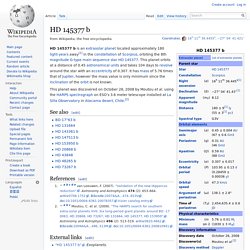
Ice planet. Characteristics and habitability[edit] Ice planets usually appear nearly white with geometric albedos of more than 0.9.
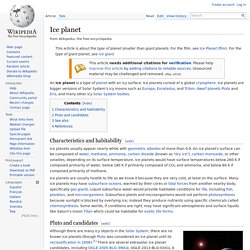
An ice planet's surface can be composed of water, methane, ammonia, carbon dioxide (known as "dry ice"), carbon monoxide, or other volatiles, depending on its surface temperature. Ice planets would have surface temperatures below 260 K if composed primarily of water, below 180 K if primarily composed of CO2 and ammonia, and below 80 K if composed primarily of methane.
109 Piscium b. 109 Piscium b (aka HD 10697 b) is a long-period extrasolar planet discovered in orbit around 109 Piscium.

It is at least 6.38 times the mass of Jupiter and is likely to be a gas giant. As typical for long-period planets discovered around other stars, it has an orbital eccentricity greater than that of Jupiter. The discoverers estimate its effective temperature as 264 K from solar heating, but it could be at least 10-20 K warmer because of internal heating.[3] Preliminary astrometric measurements suggested that the orbital inclination is 170.3°,[4] yielding an object mass of 38 times that of Jupiter, which would make it a brown dwarf.
However, subsequent analysis indicates that the precision of the measurements used to derive the astrometric orbit is insufficient to constrain the parameters, so the true inclination and mass remain unknown.[5] A more plausible suggestion is that this planet shares its star's inclination, of 69+21 −26°.[6][7] XO-3b. XO-3b is an exoplanet with about 11.79 times the mass of Jupiter, and an orbit around its parent star in about 3.2 days.[7] The radius of this object is 1.217 times that of Jupiter.
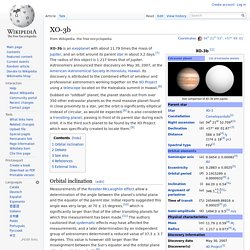
Astronomers announced their discovery on May 30, 2007, at the American Astronomical Society in Honolulu, Hawaii. Its discovery is attributed to the combined effort of amateur and professional astronomers working together on the XO Project using a telescope located on the Haleakala summit in Hawaii.[8] Dubbed an "oddball" planet, the planet stands out from over 350 other extrasolar planets as the most massive planet found in close proximity to a star, yet the orbit is significantly elliptical instead of circular, as would be expected.[8] It is also considered a transiting planet, passing in front of its parent star during each orbit. It is the third such planet to be found by the XO Project which was specifically created to locate them.[9] 83 Leonis Bb. References[edit] External links[edit] "83 Leonis AB".
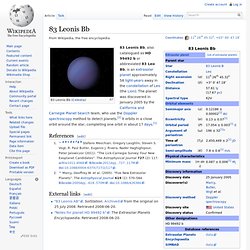
OGLE-TR-56b. The radial velocity trend of OGLE-TR-56, caused by the presence of OGLE-TR-56 b.

The planet is theorized to have iron rain.[5] See also[edit] Optical Gravitational Lensing Experiment (OGLE) GJ 1214 b. GJ 1214 b (sometimes called Gliese 1214 b[8]) is an exoplanet that orbits the star GJ 1214.
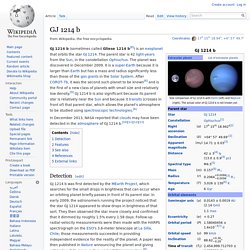
The parent star is 42 light-years from the Sun, in the constellation Ophiuchus. The planet was discovered in December 2009. It is a super-Earth because it is larger than Earth but has a mass and radius significantly less than those of the gas giants in the Solar System. HD 70573 b. References[edit] Setiawan et al.; Weise, P.; Henning, Th.; Launhardt, R.; Müller, A.; Rodmann, J. (2007).
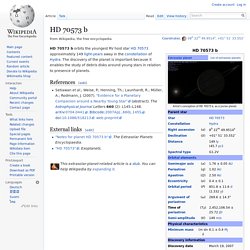
"Evidence for a Planetary Companion around a Nearby Young Star" (abstract). The Astrophysical Journal Letters 660 (2): L145–L148. arXiv:0704.0441. Bibcode:2007ApJ...660L.145S. doi:10.1086/518213. web preprint. 55 Cancri b. Simulation of the extrasolar planet 55 Cancri b. 55 Cancri b (abbreviated 55 Cnc b and occasionally referred to as 55 Cancri Ab in order to distinguish it from the star 55 Cancri B) is an extrasolar planet orbiting the Sun-like star 55 Cancri A every 14.65 days. It is the second planet in order of distance from its star, and is an example of a hot Jupiter, or possibly rather "warm Jupiter".[4] Discovered in 1996 by Geoffrey Marcy and R. Paul Butler, 55 Cancri b was the fourth known extrasolar planet, excluding pulsar planets.
HD 46375 b. References[edit] Butler, R. P. et al. (2006). "Catalog of Nearby Exoplanets". The Astrophysical Journal 646 (1): 505–522. arXiv:astro-ph/0607493. HD 147513 b. Coordinates: Kepler-68d. Kepler-68d is a gas giant with the minimum mass about the same as Jupiter. BD-08°2823 c. BD-08°2823 c (also known as HIP 49067 c) is an extrasolar planet which orbits the K-type main sequence star BD-08°2823, located approximately 137 light years away in the constellation Sextans. This planet has at least one-thirds the mass of Jupiter and takes 7.8 months to orbit the star at a semimajor axis of 0.68 AU.
This planet was detected by HARPS on October 19, 2009, together with 29 other planets, including BD-08°2823 b. Hebrard et al. (2009). "The HARPS search for southern extra-solar planets⋆ XX. HD 40307 g. HD 40307 g is an exoplanet orbiting in the habitable zone of HD 40307. It is located 42 light-years away in the direction of the southern constellation Pictor. The planet was discovered by the radial velocity method, using the European Southern Observatory's HARPS apparatus[5][10][11] by a team of astronomers led by Mikko Tuomi at the University of Hertfordshire and Guillem Anglada-Escude of the University of Goettingen, Germany.[11] HD 117207 b. XO-4b. It takes only 4.125 days (or 99 hours) to orbit at a distance of 8.3 gigameters (0.0555 AU) away from the star.[3]
TrES-2b. This planet continues to be studied by other projects and the parameters are being improved continuously. A 2007 study improved stellar and planetary parameters.[4] A 2008 study concluded that the TrES-2 system is a binary star system. This has a significant effect on the values for the stellar and the planetary parameters.[1] HD 192263 b. Ocean planet. En.wikipedia. 23 Librae c (23 Lib c) is an extrasolar planet like Jupiter discovered in 2009 orbiting the star 23 Librae. It has one of the longest known orbits of a planet detected via radial velocity.[1] The actual orbital period of this planet range from 4600 to 5400 days, or from 12.5 to 15 years. Kepler-11f. HD 231701 b. HD 180902 b. OGLE-2003-BLG-235Lb/MOA-2003-BLG-53Lb.
WASP-16b. Kepler-22b. KELT-2Ab. HD 86264 b. HD 86081 b. HD 20868 b. HD 69830 b.